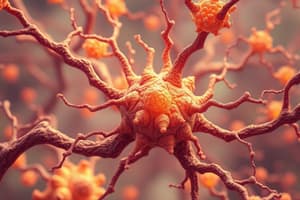Podcast
Questions and Answers
What is the primary function of the medial corticospinal tract?
What is the primary function of the medial corticospinal tract?
- Controlling the muscles of the hands and fingers
- Initiating bilateral movements such as walking and turning (correct)
- Facilitating synaptic plasticity in the spinal cord
- Regulating sensory information from the environment
What is a characteristic of Parkinson's disease?
What is a characteristic of Parkinson's disease?
- Enhanced sensory perception
- Muscle tremors and rigidity (correct)
- Rapid and uncontrolled movements
- Increased synaptic plasticity in the spinal cord
What is the role of synaptic plasticity in learning?
What is the role of synaptic plasticity in learning?
- Controlling the medial corticospinal tract
- Facilitating sensory transmission
- Regulating learning and memory (correct)
- Enhancing muscle contraction force
What type of neurons release normal amounts of neurotransmitter in response to a single stimulus?
What type of neurons release normal amounts of neurotransmitter in response to a single stimulus?
What is the term for the process by which motor neurons release neurotransmitter in response to the integration of multiple stimuli?
What is the term for the process by which motor neurons release neurotransmitter in response to the integration of multiple stimuli?
Which of the following is NOT a characteristic of the medial corticospinal tract?
Which of the following is NOT a characteristic of the medial corticospinal tract?
What is the primary function of sensory neurons?
What is the primary function of sensory neurons?
What is the term for the impairment in initiating spontaneous physical activity in Parkinson's disease?
What is the term for the impairment in initiating spontaneous physical activity in Parkinson's disease?
What is the primary function of the Globus Pallidus?
What is the primary function of the Globus Pallidus?
What is the characteristic feature of the Huntingtin protein?
What is the characteristic feature of the Huntingtin protein?
What is the effect of repeated stimulation on the presynaptic sensory neuron?
What is the effect of repeated stimulation on the presynaptic sensory neuron?
Which of the following is a consequence of diminished activity between motor neurons and muscles?
Which of the following is a consequence of diminished activity between motor neurons and muscles?
What is the function of the Lateral Corticospinal Tract?
What is the function of the Lateral Corticospinal Tract?
What is the effect of sensitization on a stimulus?
What is the effect of sensitization on a stimulus?
Which brain area is involved in the control of movement in peripheral areas?
Which brain area is involved in the control of movement in peripheral areas?
What is the result of a mutation in a single gene - huntingtin?
What is the result of a mutation in a single gene - huntingtin?
What is the function of corticospinal tracts in the nervous system?
What is the function of corticospinal tracts in the nervous system?
What is the primary mechanism underlying synaptic plasticity?
What is the primary mechanism underlying synaptic plasticity?
What is the term for the involuntary, spasmodic movements characteristic of certain movement disorders?
What is the term for the involuntary, spasmodic movements characteristic of certain movement disorders?
Which structure is responsible for transmitting messages from the brain to the medulla and spinal cord to control muscle movement?
Which structure is responsible for transmitting messages from the brain to the medulla and spinal cord to control muscle movement?
What is the term for the ability of an organism to focus on a specific stimulus while ignoring others?
What is the term for the ability of an organism to focus on a specific stimulus while ignoring others?
Which type of neuron is responsible for transmitting information from the environment to the brain?
Which type of neuron is responsible for transmitting information from the environment to the brain?
What is the term for the reduction in response to a stimulus after repeated exposure?
What is the term for the reduction in response to a stimulus after repeated exposure?
Which nucleus is affected in Huntington's disease, leading to movement abnormalities?
Which nucleus is affected in Huntington's disease, leading to movement abnormalities?
Flashcards are hidden until you start studying
Study Notes
Corticospinal Tracts
- Medial Corticospinal Tract: a set of axons from various parts of the cortex that control muscles of the neck, shoulders, and trunk, responsible for bilateral movements like walking, turning, and standing up.
- Axons of the medial tract go to both sides of the spinal cord.
Movement Disorders
- Parkinson's Disorder: a neurodegenerative disorder characterized by muscle tremors, rigidity, slow movements, and difficulty initiating physical and mental activity.
- Associated with neurodegeneration, or the deterioration and death of neurons.
Basal Ganglia
- A group of large subcortical structures in the forebrain that receive input from the cerebral cortex and send output to the globus pallidus.
- Structures involved: caudate nucleus and putamen.
- Responsible for spontaneous, self-initiated behaviors, attention, and the ability to shift attention and attend to visual stimuli.
Huntington's Disease
- A genetic disorder caused by an autosomal dominant mutation of a single gene, resulting in a trinucleotide repeat (cytosine, adenine, guanine).
- Symptoms emerge during middle age, including chorea (involuntary, spasmodic movement), impaired coordination and balance, muscle rigidity, difficulty speaking and/or swallowing, cognitive symptoms (dementia), and psychiatric symptoms (depression).
Synaptic Plasticity
- A mechanism that allows the strength of connections between neurons to increase or decrease as a function of experience.
- Types of synaptic plasticity:
- Sensitization: repeated stimulation of a single stimulus gains the ability to influence more than one neural pathway.
- Habituation: repeated stimulation reduces the size of excitatory postsynaptic potential.
Mechanism of Synaptic Plasticity
- Repeated stimulation depletes the amount of available neurotransmitter in the presynaptic sensory neuron, leading to a decrease in the strength of synaptic transmission.
Studying That Suits You
Use AI to generate personalized quizzes and flashcards to suit your learning preferences.




